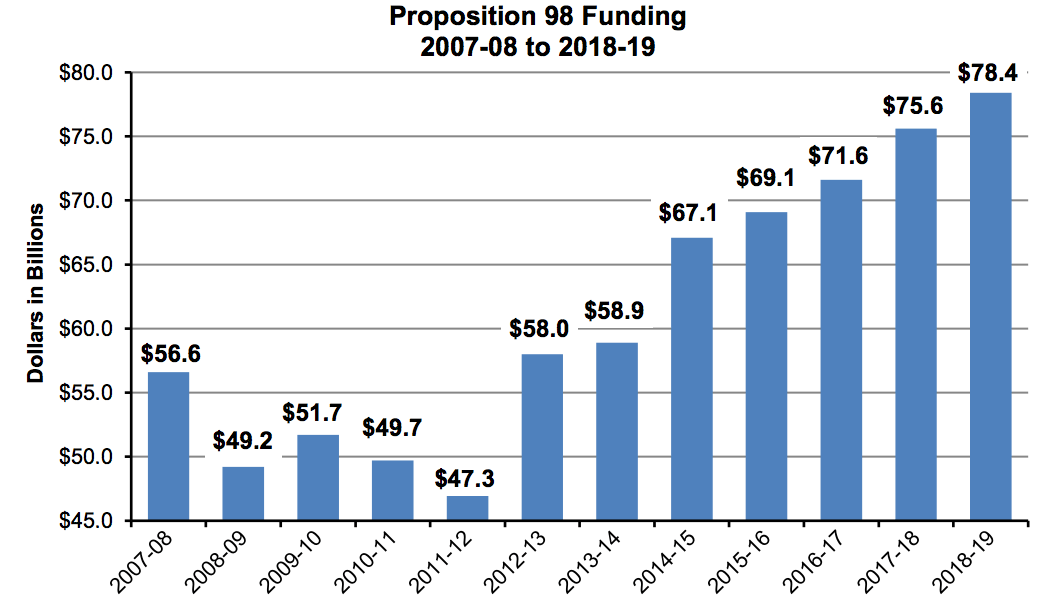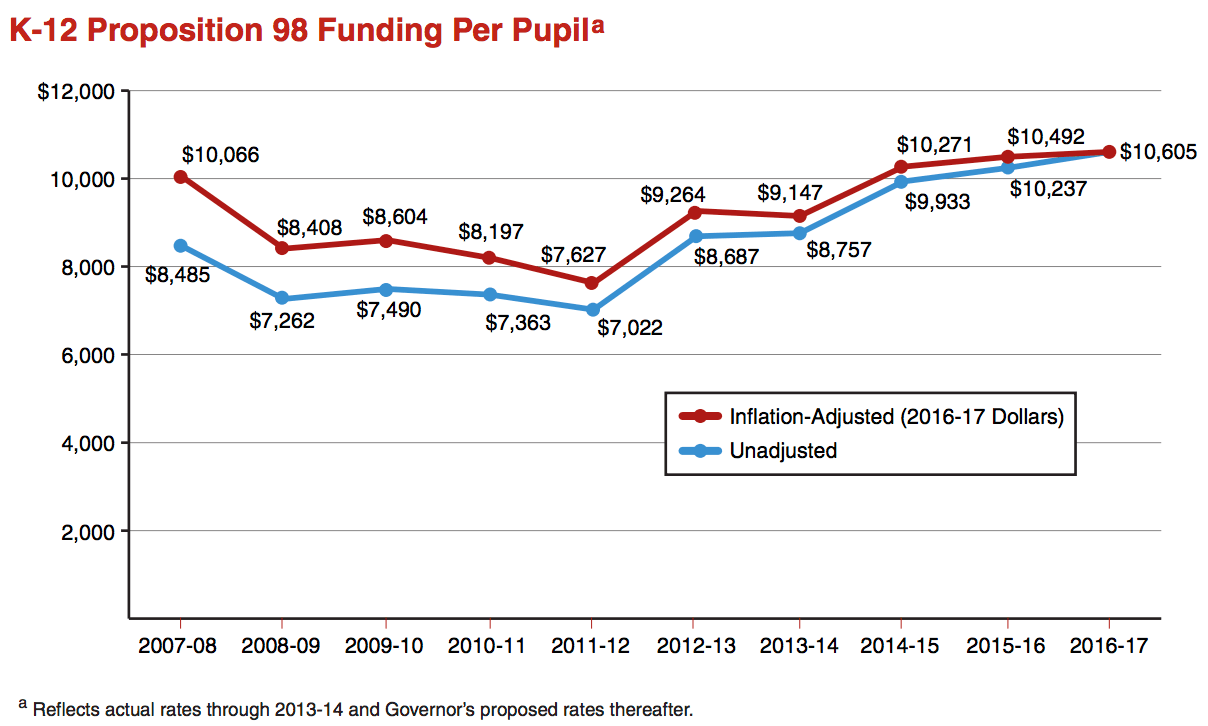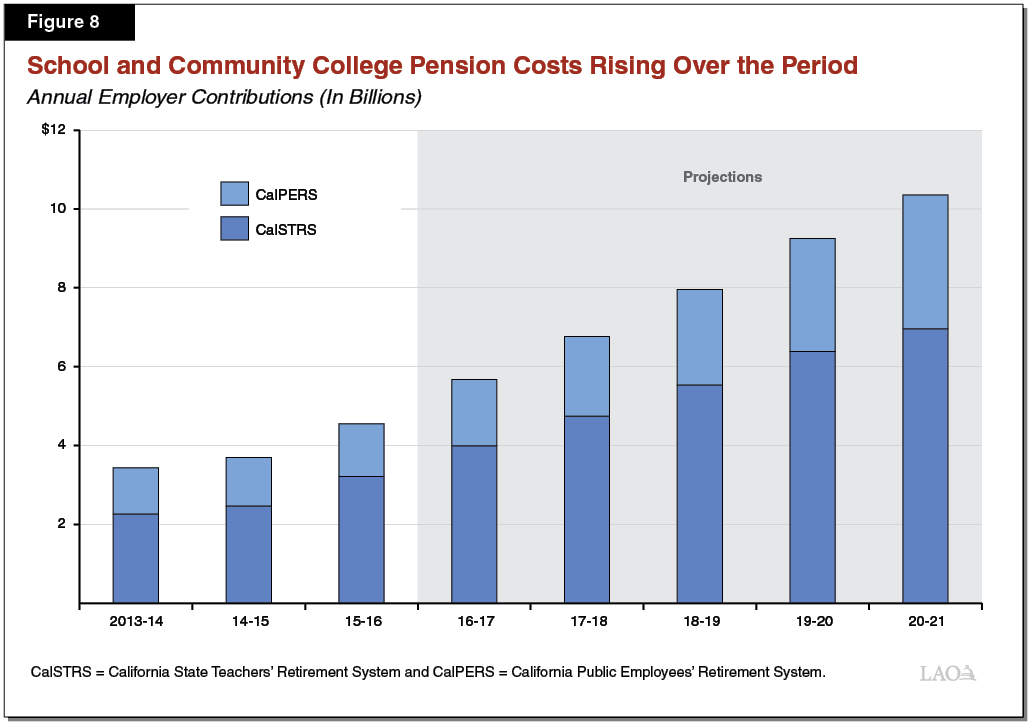More Money for Schools? No, Not Really.

More Money for Schools? Not Really.
The headlines boast that California will have a lot more money for schools in the 2018-2019 state budget. Is that the full story? Let’s take a closer look.
The good news is that funding for California schools has grown! By billions! Over the past seven years, K-12 education funding increased by $31 billion to $78.4 billion. Just look at the chart below, from the California 2018-19 State Budget:

Now, Let’s Take Another Look
Anyone who runs a household or is in charge of paying bills knows there many ways of looking at a budget. First clue: Don’t just look at revenue.
Years ago, I tried to teach my kids how to estimate costs at the grocery store. Could they figure out — just by looking at the items in the cart — how much money we would spend? Our trick was to multiply each item by $2. If we had ten items, we would guess the bill would be $20. We came pretty close.
Try using that $2 estimate today. What cost $20 in groceries in 2000 now costs $30 for the same items. That’s one of the things missing from the chart above — a little thing called inflation.
The chart below looks at basically the same revenue information as the chart at the top, but it draws a very different conclusion.
 Source: California Legislative Analyst Office (LAO)
Source: California Legislative Analyst Office (LAO)
If you just look at the blue line, it appears that we’ve increased funding per pupil significantly since 2007-08. That’s great news, right?
But when adjusted for inflation — the red line — the news doesn’t look as good. Yes, revenue has grown. But so has the cost of running a school. What’s the growth in per pupil funding adjusted for inflation over the past decade? Not much.
California is still just digging its way out of the deep budget cuts of the Great Recession. It’s now back to the funding level of a decade ago when California was well behind the national average in education funding.
Now Add Some Big Ticket items to Your Expenses
What if your grocery needs suddenly got a lot more expensive? Hello new baby AND the price of bread jumps from $2 a loaf to $5 a loaf? Right. Your grocery budget would not go as far.
That’s what happening to school budgets. Most notably, costs have skyrocketed because of changes in the way pensions are funded. For many years, too little money went into the pension system. It wasn't sustainable, and now school districts and teachers are playing catch-up to fill the gap. In the last few years, school districts and teachers have had to pay a lot more in pension contributions, and the rates are still rising. Significant pension costs have been shifted from the future to the present and from the state to local school districts — without dedicated extra money to pay for this.

Wait... there's more.
 Legislative Analyst Office (LAO) reports about a decade apart show that local budgets have carried a rising share of the cost of providing special education in California.
Legislative Analyst Office (LAO) reports about a decade apart show that local budgets have carried a rising share of the cost of providing special education in California.Special education costs for school districts have almost doubled since 2004. While there is some state and federal funding for special education, it falls far short of the actual growing costs. School districts must pick up the difference. This is big money. California school districts pay about $13 billion for special education services and almost two-thirds of it ($8.8 billion) now comes out of local budgets.
Add to that increased healthcare costs, greater expenses to address the teacher shortage, and declining enrollment and you have more money going out (expenses) than coming in (revenue).
The Bottom Line: Schools Face Budget Cuts
Combine these factors and the rosy headline that “California has lots more money for schools” makes no sense. More money isn't the same as more resources. Below are real headlines from around the state:
- SFUSD expects budget cuts despite funding boost in coming school year (SF Examiner)
- Budget Cuts Kill New Sacramento Summer School Program (MSN)
- California Schools Painful Cuts (Mercury News)
- LAUSD cuts positions to plug a budget hole without increasing class sizes (LA School Report)
Want More Budget Information? The California State PTA Budget Highlights for Parents gives you a quick rundown of funding for children and families in the 2018-2019 California budget. For a deeper dive, try these:
- 2018 — 2019 California State budget
- California Budget & Policy Center Analysis
- The Silent Recession: Why California School Districts are Underwater Despite increases in Funding
Tags on this post
Budgets Pensions STRSAll Tags
A-G requirements Absences Accountability Accreditation Achievement gap Administrators After school Algebra API Arts Assessment At-risk students Attendance Beacon links Bilingual education Bonds Brain Brown Act Budgets Bullying Burbank Business Career Carol Dweck Categorical funds Catholic schools Certification CHAMP Change Character Education Chart Charter schools Civics Class size CMOs Collective bargaining College Common core Community schools Contest Continuous Improvement Cost of education Counselors Creativity Crossword CSBA CTA Dashboard Data Dialogue District boundaries Districts Diversity Drawing DREAM Act Dyslexia EACH Early childhood Economic growth EdPrezi EdSource EdTech Education foundations Effort Election English learners Equity ESSA Ethnic studies Ethnic studies Evaluation rubric Expanded Learning Facilities Fake News Federal Federal policy Funding Gifted Graduation rates Grit Health Help Wanted History Home schools Homeless students Homework Hours of opportunity Humanities Independence Day Indignation Infrastructure Initiatives International Jargon Khan Academy Kindergarten LCAP LCFF Leaderboard Leadership Learning Litigation Lobbyists Local control Local funding Local governance Lottery Magnet schools Map Math Media Mental Health Mindfulness Mindset Myth Myths NAEP National comparisons NCLB Nutrition Pandemic Parcel taxes Parent Engagement Parent Leader Guide Parents peanut butter Pedagogy Pensions personalized Philanthropy PISA Planning Policy Politics population Poverty Preschool Prezi Private schools Prize Project-based learning Prop 13 Prop 98 Property taxes PTA Purpose of education puzzle Quality Race Rating Schools Reading Recruiting teachers Reform Religious education Religious schools Research Retaining teachers Rigor School board School choice School Climate School Closures Science Serrano vs Priest Sex Ed Site Map Sleep Social-emotional learning Song Special ed Spending SPSA Standards Strike STRS Student motivation Student voice Success Suicide Summer Superintendent Suspensions Talent Teacher pay Teacher shortage Teachers Technology Technology in education Template Test scores Tests Time in school Time on task Trump Undocumented Unions Universal education Vaccination Values Vaping Video Volunteering Volunteers Vote Vouchers Winners Year in ReviewSharing is caring!
Password Reset
Search all lesson and blog content here.
Login with Email
We will send your Login Link to your email
address. Click on the link and you will be
logged into Ed100. No more passwords to
remember!














Questions & Comments
To comment or reply, please sign in .
Jennifer B July 11, 2018 at 1:04 pm
Jeff Camp October 8, 2018 at 11:59 am